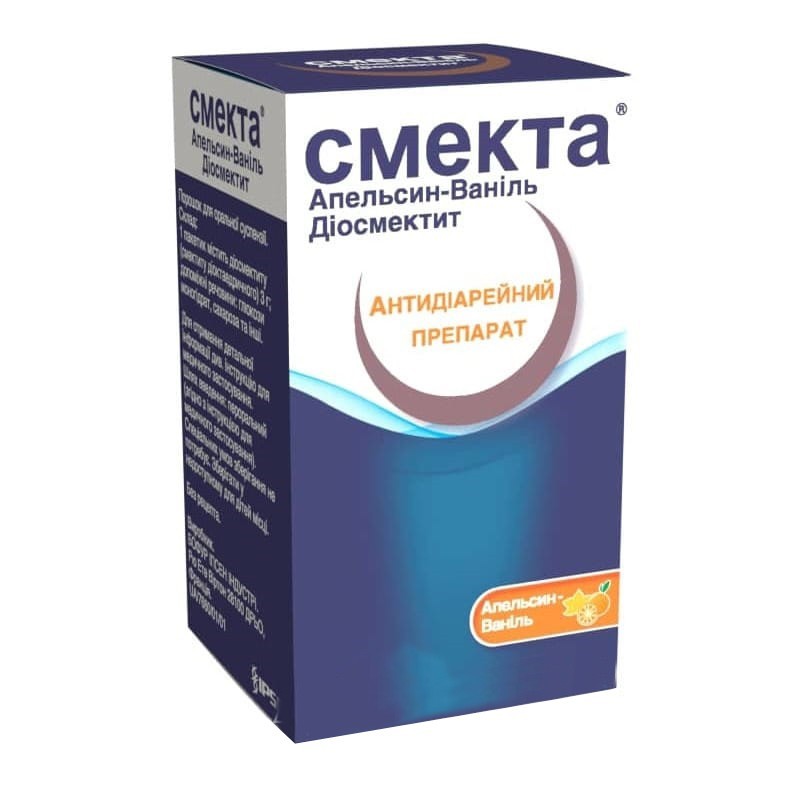



 Secure and encrypted payment processing
Secure and encrypted payment processing We ship to over 40 countries including the USA, UK, Europe, Australia and Japan
We ship to over 40 countries including the USA, UK, Europe, Australia and Japan Guaranteed refund or reship if you haven't received your order
Guaranteed refund or reship if you haven't received your orderSmecta is a double silicate of aluminum and magnesium. Due to the stereometric structure and high plastic viscosity of smect, orange-vanilla has a high enveloping ability relative to the gastrointestinal mucosa. smecta orange-vanilla through interaction with glycoproteins of the mucous membrane increases the resistance of mucus to irritants. smecta orange-vanilla, due to the influence on the barrier function of the mucous membrane of the digestive system and high ability to bind, protects the gastrointestinal mucosa.
Smecta Orange-Vanilla is radiolucent, does not stain feces and in normal doses does not affect the physiological time of passage through the intestine.
The combined results of two double-blind, randomized trials that examined the efficacy of Smecta Orange-Vanilla versus placebo in 602 patients aged 1–36 months with acute diarrhea showed a significant decrease in the frequency of emptying during the first 72 hours in the patient group. who received therapy with Smecta Orange-Vanilla in combination with oral rehydration.
Pharmacokinetics Due to the structure of diosmectite, Smecta is not adsorbed and not metabolized.
Symptomatic treatment of acute diarrhea in children and infants (in complex therapy with r-rum for oral rehydration) and adults;
Treatment for acute diarrhea
Children aged 1 month to 1 year: 2 sachets per day for 3 days, then 1 sachet per day.
Children over the age of 1 year: 4 sachets per day for 3 days, then 2 sachets per day.
Adults: an average of 3 sachets per day. The dose of the drug can be doubled at the beginning of treatment.
Other indications
Children aged 1 month to 1 year: 1 sachet per day.
Children aged 1 to 2 years: 1-2 sachets per day.
Children over the age of 2 years: 2-3 sachets per day.
Adults: 3 sachets per day.
Method of application: the contents of the bag must be mixed until a suspension is obtained immediately before use.
It is recommended to take: after eating with esophagitis; between meals - with other indications.
Children: the contents of the bag can be mixed in a bottle with 50 ml of water for use during the day or mixed well with foods such as broth, compote, mashed potatoes, baby food.
Adults: The contents of the bag can be mixed with ½ cup of water.
Hypersensitivity to diosmectide or one of the excipients of the drug; intestinal obstruction.
The frequency of side effects was classified as follows: often (≥1 / 100, 1/10), infrequently (≥1 / 1000, ≤1 / 100).
From the digestive tract: often - constipation, which usually occurs after a dose reduction, but in some cases may require discontinuation of treatment; infrequently - flatulence, vomiting.
During the post-registration period, cases of hypersensitivity reactions (unknown frequency) were reported, including urticaria, rash, pruritus, and angioedema.
Cases of constipation have also been reported.
Diosmectitis should be taken with caution in patients with a history of severe chronic constipation.
The drug is used to treat children and infants from the age of 1 month.
In children, acute diarrhea should be treated in combination with the early use of r-ra for oral rehydration to prevent dehydration.
For adults, rehydration is used if necessary.
The volume of rehydration using a solution for oral or iv rehydration depends on the intensity of diarrhea, the age of the patient, and the characteristics of the course of the disease.
The patient should be advised of the need:
The drug contains glucose and sucrose. The drug is not recommended for patients with fructose intolerance, glucose and galactose malabsorption, or sucrose-isomaltase deficiency.
Use during pregnancy and lactation. Reliable data on teratogenesis in animals are not available.
To date, in clinical conditions, no specific fetal malformations or fetotoxic effect have been identified. However, observations of the effect of Smecta Orange-Vanilla on pregnant women, sufficient to exclude any risk, were not carried out.
Therefore, taking into account the fact that Smecta Orange-Vanilla is not absorbed, the use of this drug during pregnancy is provided only if necessary.
The ability to influence the reaction rate when driving vehicles or working with other mechanisms. Studies on the ability to drive vehicles and work with other mechanisms under the influence of this drug have not been conducted. However, its impact is expected to be negligible or even absent.
Children. The drug is used to treat children from the age of 1 month.
The adsorbing properties of this drug may affect the degree and / or absorption rate of other substances, therefore it is recommended not to use other drugs simultaneously with the preparation of orange-vanilla smecta.
Overdosing can result in severe constipation or bezoar.
Special storage conditions are not required. Keep out of the reach of children.